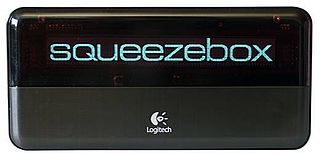
Bluetooth is a short-range wireless technology standard that is used for exchanging data between fixed and mobile devices over short distances and building personal area networks (PANs). In the most widely used mode, transmission power is limited to 2.5 milliwatts, giving it a very short range of up to 10 metres (33 ft). It employs UHF radio waves in the ISM bands, from 2.402 GHz to 2.48 GHz. It is mainly used as an alternative to wired connections to exchange files between nearby portable devices and connect cell phones and music players with wireless headphones.
Windows Media Audio (WMA) is a series of audio codecs and their corresponding audio coding formats developed by Microsoft. It is a proprietary technology that forms part of the Windows Media framework. WMA consists of four distinct codecs. The original WMA codec, known simply as WMA, was conceived as a competitor to the popular MP3 and RealAudio codecs. WMA Pro, a newer and more advanced codec, supports multichannel and high-resolution audio. A lossless codec, WMA Lossless, compresses audio data without loss of audio fidelity. WMA Voice, targeted at voice content, applies compression using a range of low bit rates. Microsoft has also developed a digital container format called Advanced Systems Format to store audio encoded by WMA.
OpenMAX, often shortened as "OMX", is a non-proprietary and royalty-free cross-platform set of C-language programming interfaces. It provides abstractions for routines that are especially useful for processing of audio, video, and still images. It is intended for low power and embedded system devices that need to efficiently process large amounts of multimedia data in predictable ways, such as video codecs, graphics libraries, and other functions for video, image, audio, voice and speech.

A portable media player (PMP) or digital audio player (DAP) is a portable consumer electronics device capable of storing and playing digital media such as audio, images, and video files. The data is typically stored on a compact disc (CD), Digital Versatile Disc (DVD), Blu-ray Disc (BD), flash memory, microdrive, SD cards or hard drive; most earlier PMPs used physical media, but modern players mostly use flash memory. In contrast, analogue portable audio players play music from non-digital media that use analogue media, such as cassette tapes or vinyl records.
The Motorola ROKR, the first version of which was informally known as the iTunes phone, was a series of mobile phones from Motorola, part of a 4LTR line developed before the spin out of Motorola Mobility. ROKR models were released starting in September 2005 and ending in 2009. They were notable for incorporating support of media player features.

Lyrion Music Server is a streaming audio server supported by the LMS community and formerly supported by Logitech, developed in particular to support their Squeezebox range of digital audio receivers.

Squeezebox is a family of network music players. The original device was the SliMP3, introduced in 2001 by Slim Devices. It had an Ethernet interface and played MP3 music files from a media server. The first Squeezebox was released two years later and was followed by several more models. Slim Devices was acquired by Logitech in 2006.

Zune was a brand of digital media products and services that was marketed by Microsoft from November 2006 until it was discontinued in June 2012. Zune consisted of a line of portable media players, a music subscription service known as Zune Music Pass plus Zune Marketplace for music, TV and movies, streaming services for the Xbox 360 game console, and the Zune software media player for Windows PCs which also acted as desktop sync software for Windows Phone.
A Bluetooth stack is software that is an implementation of the Bluetooth protocol stack.

The Voq Professional Phone is a tri-band Smartphone based on a 200 MHz Intel XScale PXA262 processor with stacked flash memory, running on Microsoft Windows Mobile 2003 edition. Announced on October 8, 2003, the product combines elements of a mobile phone, a personal messaging device, and a PDA with such distinctive features as a flip-open QWERTY thumbpad.

aptX is a family of proprietary audio codec compression algorithms owned by Qualcomm, with a heavy emphasis on wireless audio applications.

Stonestreet One was a software company specializing in Bluetooth software solutions. Founded in 1999 in Louisville, Kentucky, Stonestreet One created and sold software for the Bluetooth wireless technology industry. They specialized in solutions for chipmakers, distributors, embedded software companies and Original Equipment Manufacturers. Stonestreet One was acquired by Qualcomm in 2014.
Movial is a privately held software engineering company focused on Internet enabled devices in consumer electronics and telecommunications industries. The company’s services include device concept and user interface (UI) design, third-party application, service and platform integration, and consulting.

LDAC is a proprietary audio coding technology developed by Sony, which allows streaming high-resolution audio over Bluetooth connections at up to 990 kbps at 32 bits/96 kHz. It is used by various products, including headphones, earphones, smartphones, portable media players, active speakers, and home theaters.
A microphone blocker is a phone microphone connector used to trick feature phones that have a physical microphone switch to disconnect the microphone. Microphone blockers won't operate on smartphones or laptops because the microphone is controlled with software rather than a physical switch.

AirPods Pro are wireless Bluetooth in-ear headphones designed by Apple, initially introduced on October 30, 2019. They are Apple's mid-range wireless headphones, available alongside the base-level AirPods and the highest-end AirPods Max.










